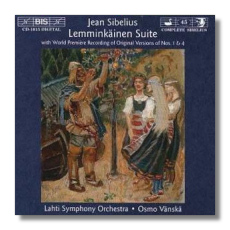
The Internet's Premier Classical Music Source
Related Links
- Sibelius Reviews
- Latest Reviews
- More Reviews
-
By Composer
-
Collections
DVD & Blu-ray
Books
Concert Reviews
Articles/Interviews
Software
Audio
Search Amazon
Recommended Links
Site News
 CD Review
CD Review
Jean Sibelius

Lemminkäinen Suite
- Lemminkäinen Suite, Op. 22 (1895) (Four Legends from the "Kalevala") final versions
- Original versions of:
- Lemminkäinen and the Maidens of the Island
- Lemminkäinen's Homeward Journey
Lahti Symphony Orchestra/Osmo Vänskä
BIS CD-1015 DDD 79:27
If you love the Lemminkäinen Suite as much as I do, this CD is an essential addition to your collection. Not only does it feature a brooding performance of the work as we usually hear it, it also includes the original versions of the first and last sections, as well as other alternate material. These have never been on CD before. Earlier releases presented Sibelius's original thoughts on his Fifth Symphony, the Violin Concerto, and so on. BIS, therefore, is really giving Sibelians fascinating opportunities to learn about the composer's thought processes. This is Volume 45 (!) in their complete Sibelius edition.
Sibelius composed this music between 1895 and 1896, with the exception of The Swan of Tuonela, which he composed in 1893. All of the sections were revised in 1897. The Swan of Tuonela and Lemminkäinen's Homeward Journey were revised one last time in 1900, and Lemminkäinen and the Maidens of the Island (also known as Lemminkäinen and the Maidens of Saari) and Lemminkäinen in Tuonela were revised in 1939 to produce the versions that we know today. Resuscitating earlier versions of this music may seems a bit like grave-robbing, but the ideas that Sibelius subsequently rejected or revised are worth hearing. Overall, the final versions are the best. However, there are too many interesting things in the earlier versions to ignore them completely.
The most dramatic changes happened to Lemminkäinen's Homeward Journey. In 1896, it was almost twice the length it is today. This first version is not very concise, but the added weight brings out a celebratory character missing from the final version. The brass fanfare that comes near the end of final version appears earlier in the 1896 version. Also, the first version contains thematic material that Sibelius completely excised in 1900. The 1896 coda is almost contemplative, not the bang-up climax that it is today.
Lemminkäinen and the Maidens of the Island also underwent significant changes, although its length remained about the same. The composer revised the orchestration in many ways, both large and small. There were more important revisions, however, in the manner in which Sibelius handled his themes. Hearing the original version creates a strong feeling of dislocation; the material is familiar, but the treatment is not. It's like seeing a picture of an old friend and discovering that he used to have different hair color and wear glasses.
At first, I was a taken aback by what seemed to be a rather undemonstrative reading by Vänskä and the Lahti Symphony Orchestra. After several auditions, I admire this performance a great deal more. It doesn't go for the jugular; it's not a "popular" reading. Instead, the performers emphasize Sibelius's dark colors. A Finnish critic once complained that this music sounded "positively pathological," and while I don't agree, Vänskä's inwardness allows one to see where the critic was coming from. Eugene Ormandy's bright-eyed and excellently played version remains a classic. Nevertheless, there is room for many different viewpoints, and Vänskä's intense thoughtfulness leaves one thinking about the music long after it is over. As usual with BIS, the engineering is outstanding, and copious annotations by Andrew Barnett help the listener to suck the marrow out of Lemminkäinen's bones.
Copyright © 1999, Raymond Tuttle


















